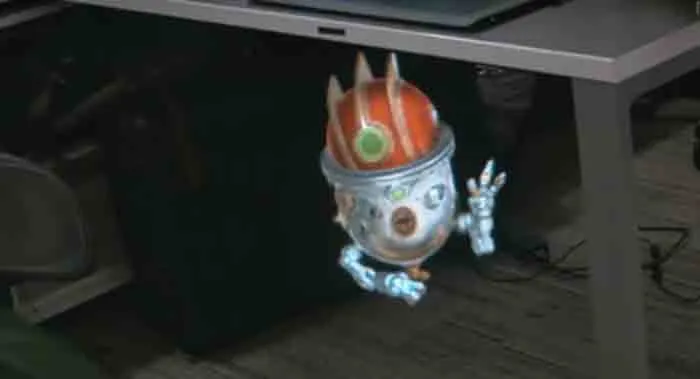Yesterday, the Google-backed startup Magic Leap broke its silence at WSJD to reveal a new 1-minute video showcasing what its technology can do while also providing hints that the company may be closer than originally thought to revealing a product.
The video shows a cute robot hiding under an office desk and a solar system floating in the middle of a room in what the startup claims is footage shot with a camera directly through the internal hardware they are working with on a daily basis.
“No special effects or compositing were used in the creation of these videos,” a disclaimer reads.
Magic Leap has raised around $592 million, with the vast majority of that money ($542 million) coming in the wake of the $2 billion acquisition of Oculus by Facebook. The huge round from investors, including Google, was announced exactly one year ago today and represented a bet on light-field technology that could be a “leap” forward in the delivery of virtual content to the eyes. It would, theoretically at least, duplicate exactly how the eyes see in the real world with fabricated objects perfectly inserted into the view of the real world.
However, the company is secretive in general and its CEO Rony Abovitz has been criticized by VR enthusiasts in the past for not showing anything more than a concept video publicly while he simultaneously raised concerns about the potential health hazards of Oculus-like VR systems. To see the Magic Leap tech first-hand, many people have to sign non-disclosure agreements, but it seems that we might be getting closer to having the veil lifted.
On stage yesterday, Abovitz said the company is “gearing up to ship millions of things,” which seems to be in line with the company’s moves in the past few months.
Magic Leap broke ground on a 260,000 square foot facility in Florida earlier this month and opened a development center in Israel back in July. Recently, Abovitz also said the company is moving out of the R&D phase “to a transitional stage for presenting a real product.”

This new footage of Magic Leap’s tech in action opens a new chapter in the company’s history, giving the world the best idea yet of what the technology might look like to a viewer. The footage begins with a plant in the foreground and an object out of focus in the distance under a table in the background, as it might actually look if your eyes were focused on the same foreground. As the camera refocuses at a greater distance it becomes clear that it’s a cute little robot, who Magic Leap has named Gimbal.
In one technically interesting moment, Gimbal becomes occluded by a leg of the table when the camera moves to the side. A second clip shows a solar system floating in the center of an office space allowing the camera to move right up close to it to see the beautiful corona up close. One of the coolest touches is that the glow of the sun is reflected realistically on the surface of the table below.
In both clips, but especially the solar system one, the lighting of the room appears pretty dim, which is a strategy employed in demos of Microsoft’s HoloLens that keep the real-world background from becoming visible through the virtual objects.
“It was filmed in my CMO’s office. His office is just lit with lamps instead of overhead lighting,” Magic Leap’s Head of PR and Government Affairs, Andy Fouché, told UploadVR.
Overall, many questions still remain about Magic Leap. Among them, how portable can the technology become in the near future? At what prices? How wide is the field of view is in comparison to HoloLens and Rift? The $3,000 price tag for the fully portable HoloLens developer kit puts it out of reach for many independent developers and may restrict the device to primarily business use at least in the first generation. It remains to be seen how the two stack up because we have only actually seen the Hololens, but based on Abovitz’s comments, that may change in the near future.

























